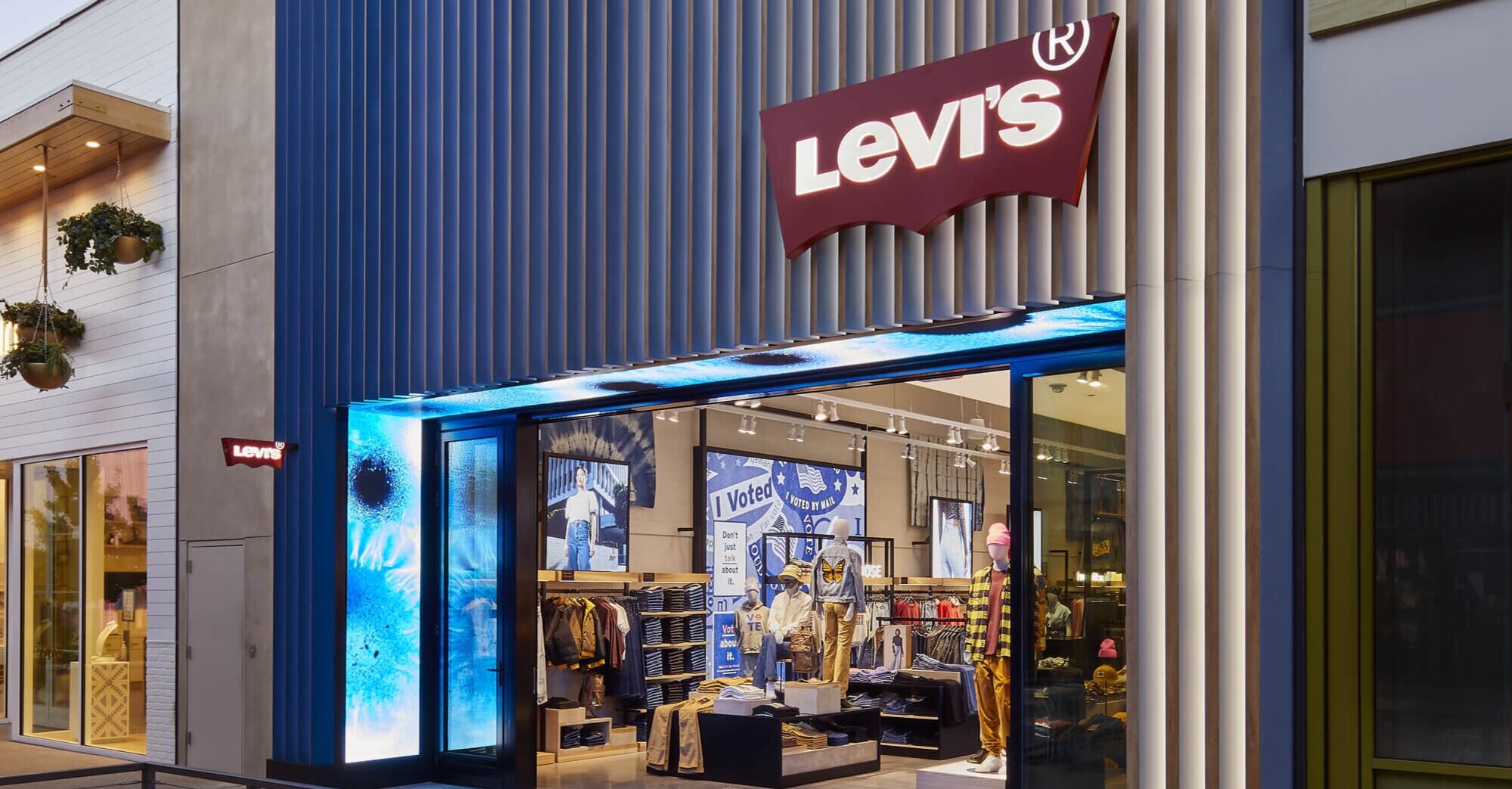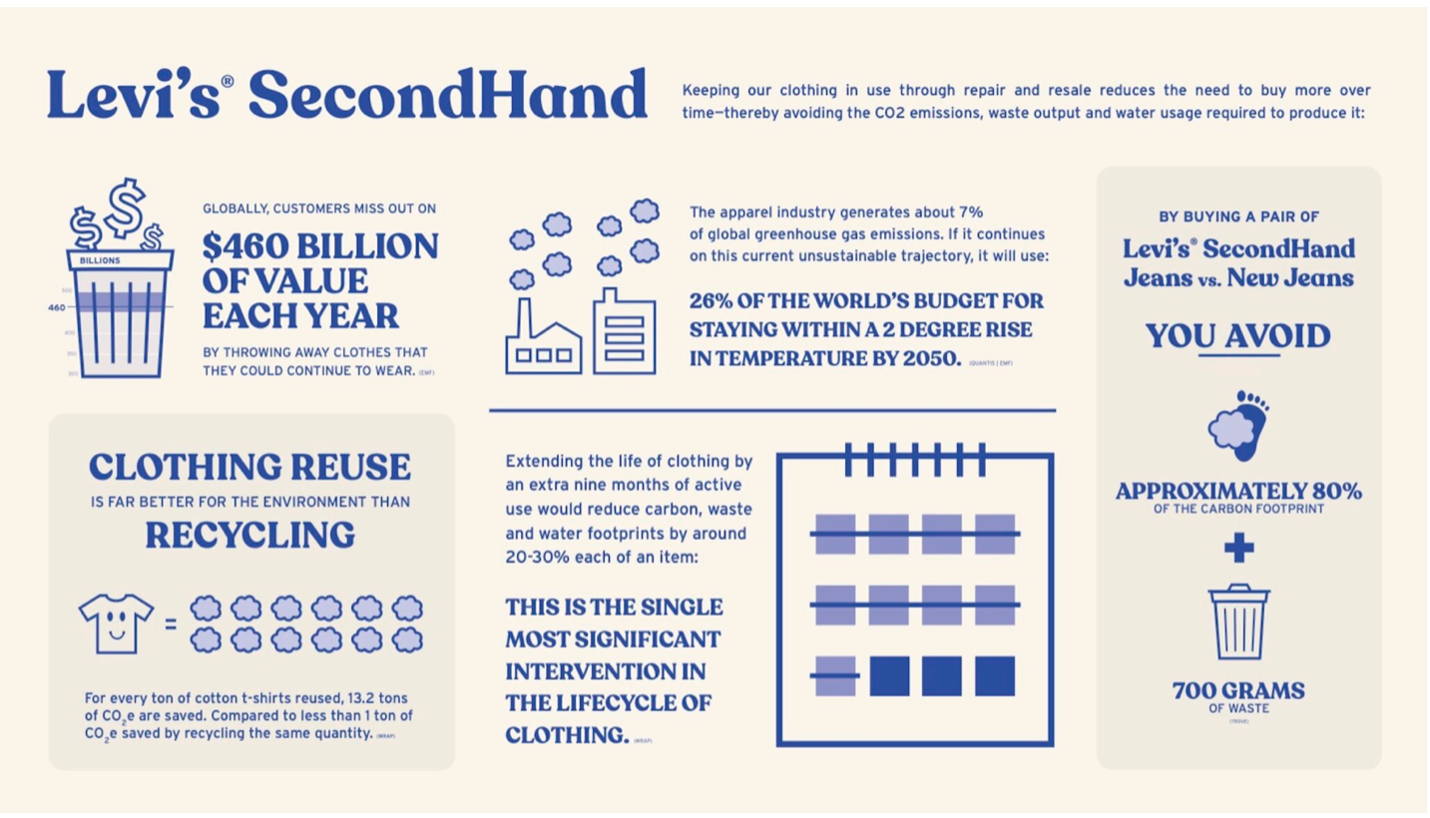Brands Like Nike & Levi’s are Going into Resale & Why You May Want to
New or used? That’s increasingly becoming an option even when shopping at some of the largest retailers in the world. With a climate crisis in our midst many consumers are focusing on sustainability. Sustainability from a retailer’s perspective is about creating, manufacturing and selling merchandise that is less harmful to the environment.
After the oil industry, the fashion industry is the world’s second largest polluter. You may not realize this but the t-shirt you are wearing, may have used, on average, between 400 – 600 gallons of water (i.e. 7-10 bathtubs full of water) in the manufacturing process.
More and more retailers are taking their environmental impact seriously because it’s the right thing to do but also because it’s good business. “More environmentally and socially aware customers are driving the emergence of new business models such as renting or buying secondhand apparel,” said Moody’s. “Fast fashion, mid-priced and small discount companies with limited resources or weak capital structures are the most at risk from these changing customer habits.”
As part of this movement Nike recently announced it is selling refurbished sneakers at 15 stores with plans to sell these sneakers at several more stores by the end of this year. If you buy a pair of Nikes and return them within 60 days they are eligible for Nike Refurbished, Nike’s resale program. As part of this program Nike inspects your returned kicks then classifies them into one of three categories: a) like new (maybe worn for a day or two before being returned, b) gently worn (a little longer than a couple of days) or c) cosmetically flawed (i.e. they have a stain, mark, or fading). If the sneakers are salvageable they are cleaned, sanitized and buffed.
Once the sneaker is refurbished it is priced lower than the original sale price. The closer the sneakers are to being new the higher the price they are resold at. If the shoe is damaged beyond repair they are moved into the Nike Grind program an initiative where unusable merchandise is turned into other uses including rubber flooring, courts and new sneakers. Unlike other retailer resale programs customers are not provided with a store credit as an incentive to return their shoes.
“Nike’s move is just the latest signal that resale represents a sea change in how consumers want to shop today,” said Andy Ruben CEO of re-commerce startup Trove. “Consumers love both the shopping experience and the value they get with resale. Strong brands know they need to own their secondary market, and I expect many more of them will follow Nike’s lead in the coming months and years.” This is Nike’s first ever resale program and while sustainability is on Nike’s mind so is the growing popularity of resale platforms like StockX and GOAT. This maneuver allows Nike to test the waters and see if it wants to have a larger role in the fast growing secondary sneaker market.
Refurbished sneakers bought from Nike are still under Nike’s 60 day wear guarantee that says if you wear them and don’t like them you can still return them. By 2025 Nike hopes to reduce its greenhouse gas emissions by 70% and within the same time period it is aiming to increase the amount of its merchandise that is donated, refurbished and reused by a factor of 10.
Levi’s is also making a large investment in the resale market by launching Levi’s SecondHand last fall. Levi’s SecondHand is a site where Levi’s is selling previously owned Levi’s denim jackets and jeans. It is partnering with Trove who is going to manage deliveries, clean garments, fulfill orders and take pictures of merchandise to be displayed online as well as other backend operations.
“We think that the demand is there and we think this is how a lot of young people prefer to shop… [this is a way] to get an understanding of that level of demand, and also to work out the kinks in how it’s executed before scaling,” said Jen Sey, Levi’s Chief Marketing Officer. “They love the hunt, they love finding a really unique item, and it makes it even better that it’s a sustainable choice,” she added. “Buying a used pair of Levi’s saves approximately 80% of the CO2 emissions, and 1.5 pounds of waste, compared to buying a new pair. As we scale this, that will really start adding up.”
“We’re encouraging people not to throw away used – or “previously loved,” as I like to say – denim, and help them see that second-hand garments deliver the same value and are still built to last while preserving the natural resources that would be needed to make a new pair of jeans,” said Levi’s in a statement.
Source: Levi’s
Like Nike, Levi’s is one of the most popular brands on resale sites. This move allows Levi’s to capture some of those sales for itself. There are no other large denim brands that are doing something similar at this time but if this initiative proves to be successful many more brands will likely follow suit.
If you donate a pair of your old Levi’s jeans then Levi’s will give you a credit for between $15 and $25 to put towards a future store purchase. If the merchandise is vintage then the credit is higher, between $30 and $35. Once the items are returned, processed and put on the Levi’s SecondHand site they will be sold for between $30 to $100.
IKEA has bold ambitions when it comes to sustainability. It plans to decrease its climate impact per item by 70% by 2030. Within that timeframe IKEA also aims to only make products made of recycled or renewable materials designed to be reused, recycled or resold. “At IKEA we don’t want to merely be a part of the sustainability movement – we want to lead it. If we want to reach our sustainability goals, we have to challenge ourselves and test our ideas. The climate crisis cannot be solved in theory, it has to be solved in practice,” says Jonas Carlehed, Sustainability Manager of IKEA Sweden.
IKEA’s commitment to protecting the environment is not lip service. It put its ambitions on display when it opened its first store last fall that sells only refurbished and sustainably manufactured merchandise. The store is located in a mall in Sweden called ReTuna where tenants only sell reused, organic or sustainability produced items. IKEA is sourcing items for its ReTuna store from municipal recycling centres. After six months IKEA will examine the project and determine if it should launch a similar initiative in other markets.
“By opening this shop, IKEA is now taking the next step. Working with ReTuna gives us the possibility to better understand why certain IKEA products turn into waste, what condition they are in when discarded, how people reason when deciding to throw away our products, and if there’s an interest in buying the products if we manage to save them,” said Carlehed. “We are making a huge readjustment, maybe the biggest IKEA has ever made, and one of the keys to reaching (the targets) is to manage to help our customers prolong the life of their products,” said Carlehed.
IKEA also announced last fall it is buying back used furniture in 27 countries in order to resell, recycle or donate them. Customers who return their furniture to IKEA will receive a store credit for up to 50% of the value of the item that is returned. By next year IKEA customers will be able to find designated areas within IKEA stores where they can drop off used furniture or buy used items for sale. “By making sustainable living more simple and accessible, IKEA hopes that the initiative will help its customers take a stand against excessive consumption,” said IKEA in a statement.
Do you like this content? If you do subscribe to our retail trends newsletter to get the latest retail insights & trends delivered to your inbox
Eileen Fisher put a spotlight on sustainability before it was even a trend. Eileen Fisher’s philosophy is: “buy quality pieces, wear them as long as possible—and when you’re done with them, pass them on to someone else.” The womenswear retailer has an entire separate line of business and website called Eileen Fisher Renew (www.eileenfisherrenew.com) where customers can shop secondhand Eileen Fisher clothing. Since 2009 Eileen Fisher Renew has taken back over 1.5 million pieces of merchandise that was then either resold, donated or turned into new designs.
“Worn-or-torn” Eileen Fisher clothing can be returned to any Eileen Fisher or Eileen Fisher Renew store in the United States. Regardless of the condition the garment is in when it is returned customers receive a $5 store credit if they donate an item. A piece of merchandise needs to be in great condition for it to be resold, if not it is donated or turned into a piece of customer artwork. Eileen Fisher uses Tersus Solutions to clean all returned merchandise so it’s ready for resale.
“Given the growth of resale, you have to wonder why every brand doesn’t do [this], instead of letting another retailer profit from their brand name,” says New York Times’ fashion director Vanessa Friedman. With big names like Nike and Levi’s getting into resale more companies sitting on the sidelines are going to wonder if they too should enter the ring.


